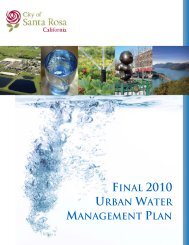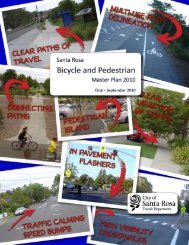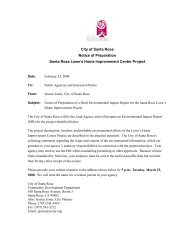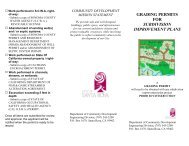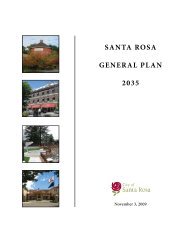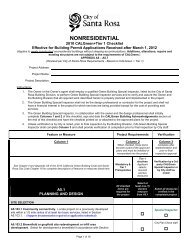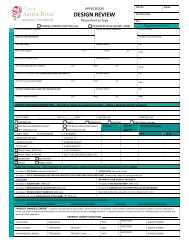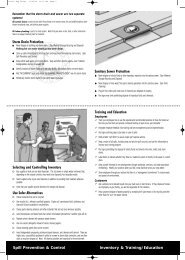Fountaingrove Environmental Impact Report - City of Santa Rosa ...
Fountaingrove Environmental Impact Report - City of Santa Rosa ...
Fountaingrove Environmental Impact Report - City of Santa Rosa ...
You also want an ePaper? Increase the reach of your titles
YUMPU automatically turns print PDFs into web optimized ePapers that Google loves.
3.6 GEOLOGY, SOILS, AND SEISMICITY<br />
The Project site is situated east <strong>of</strong> the <strong>Santa</strong> <strong>Rosa</strong> Plain, in the lower foothills <strong>of</strong> the Sonoma<br />
Mountains. The site lies within an area <strong>of</strong> gently to moderately rolling terrain on a narrow<br />
strip <strong>of</strong> undeveloped land located between Thomas Lake Harris Road on the west and a golf<br />
course fairway on the east. Maximum site relief is on the order <strong>of</strong> 100 feet, with ground<br />
surface elevations ranging from about 400 to 500 feet above mean sea level. The site<br />
generally slopes downward in a west-southwest direction. East <strong>of</strong> the site, the ground<br />
surface rises to higher elevations <strong>of</strong> the Sonoma Mountains. West <strong>of</strong> the site, a series <strong>of</strong><br />
relatively steep, southwest-facing slopes descends to the <strong>Santa</strong> <strong>Rosa</strong> Plain.<br />
Local drainage features within the Project vicinity site include subdued drainage swales,<br />
closed or nearly closed drainage depressions, and abrupt changes in stream direction and<br />
gradients (Giblin, 2006a). A seasonal, west-flowing creek is located a few hundred feet north<br />
<strong>of</strong> the Project site. A second creek, Piner Creek, flows across the south end <strong>of</strong> the site. Flows<br />
in Piner Creek are controlled by the <strong>Fountaingrove</strong> Lake dams, located approximately 800<br />
feet east <strong>of</strong> the site.<br />
Geology<br />
Geologic Setting. The California Coast Range physiographic province is located along the<br />
complex boundary margin between two tectonic plates: the North American Plate and the<br />
Pacific Plate. Geologic conditions in the Project area have been and continue to be primarily<br />
controlled by the interaction <strong>of</strong> these two massive blocks <strong>of</strong> the earth’s crust. Under the<br />
current tectonic regime, the Pacific Plate moves northwestward relative to the North<br />
American Plate at a rate <strong>of</strong> about 4 centimeters per year (WGCEP, 2003). Although relative<br />
motion between the two plates is predominantly lateral (strike-slip), an increase in<br />
convergent motion along the plate boundary within the past few million years has resulted<br />
in the formation <strong>of</strong> mountain ranges and structural valleys <strong>of</strong> the Coast Ranges province.<br />
See Figure 3.6-1 for a regional geology map.<br />
At the latitude <strong>of</strong> the Project site, the San Andreas fault system comprises several major<br />
faults, including the San Andreas, Rodgers Creek-Healdsburg, Maacama, and<br />
Concord-Green Valley Faults. In addition to these, many other named and unnamed faults<br />
within the region accommodate relative motion between major faults and relieve<br />
compressional stresses that also act along the plate boundary. See Figure 3.6-2 for the<br />
regional fault map.<br />
The nearest fault to the Project is the Rodgers Creek-Healdsburg fault, the main trace <strong>of</strong><br />
which has been identified within several hundred feet <strong>of</strong> the site. The slip rate on the<br />
Rodgers Creek fault is estimated to be approximately 9 mm/year with a recurrence interval<br />
for large earthquakes estimated at approximately 222 years (Giblin, 2006a; Appendix K).<br />
Faults can be described by one <strong>of</strong> two activity classes: active and potentially active, as<br />
defined by the CDMG (CDMG, 1992). Active describes Historic and Holocene faults that<br />
have had surface displacement within about the last 11,000 years. Potentially active<br />
describes faults showing evidence <strong>of</strong> surface displacement during Quaternary time (the past<br />
1.6 million years). A third class <strong>of</strong> faults, pre-Quaternary age faults, are classified as inactive.<br />
This classification is not meant to imply that inactive fault traces will not rupture, only that<br />
they have not been shown to have ruptured within the past 1.6 million years and that the<br />
probability <strong>of</strong> fault rupture is low.<br />
BAO\082970001 3-69



